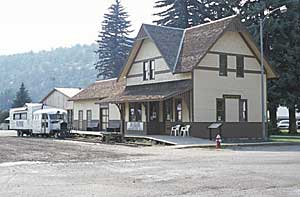© Benoit Poulin, 2002-16
|
|
|

Galloping Goose #5, a Rio Grande Southern symbol, in front of the depot in Dolores.
|
The Rio Grande Southern was a narrow gauge mountain railroad (3ft gauge) in southwestern Colorado running from Durango to Ridgway, a distance of 163 track-miles through the rugged terrain of the Rocky Mountains. It has been initiated in 1889 by Otto Mears, who also built several of the railroads serving Silverton mining district. Its construction was completed in 1891, creating a rail-link to the then booming mining communities of Placerville, Ophir, Rico and Telluride. The Rio Grande Southern was connected to the Denver & Rio Grande narrow gauge system at its ends in Durango and Ridgway.
The prosperity of the railroad lasted only a few years and it was soon placed in receivership under the control of the mighty Denver & Rio Grande. Nevertheless, the railroad survived as a subsidiary of the Denver & Rio Grande, with very limited means, using mostly second hand or leased equipment and with maintenance of the physical plant kept to a minimum. At the 1929 financial crisis, the Rio Grande Southern was again placed in receivership and the Denver & Rio Grande Western lost its control. Conventional steam passenger trains, too costly and losing money, were discontinued and replaced by light mixed trains operated with novel equipment built by the Rio Grande Southern, hybrids between a truck and a bus fitted to run on railroad tracks. These unique and original railbuses, officially called Motors by the railroad, were quickly nicknamed Galloping Goose and greatly contributed to the fame of the Rio Grande Southern among railfans.
|
|

Typical landscape in the Rio Grande Southern country: the old right-of-way along Trout Lake is now a dirt road. The water tank is still standing.
|
The use of the Goose allowed the railroad to run the few trains still needed to cover the fainting traffic with the lowest possible expenses and the company managed to survive until World War II. After the war, the last sources of revenue (ore, lumber, livestock) dried-up and it became clear that the Rio Grande Southern wasn't going to last very long. More and more services were transfered to trucks, the mail contract was lost and at the end of the fourties, the railroad had lost virtually all traffic and was losing a lot of money. The last attempt to use the Galloping Goose for excursion trains by advertizing the wonderfull scenery along the line didn't change the financial situation of the railroad and all operations ceased by the end of 1951. The year after, the line was abandoned and scrapped right away.
Today only a few traces of the Rio Grande Southern remain, scattered along the old right-of-way in this remote area of Colorado. Some of the rolling stock has been preserved, particularly at the Colorado Railroad Museum in Golden. It is worth to mention that most of the Galloping Goose have survived today, almost all of them still operational.
|


